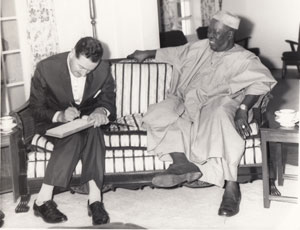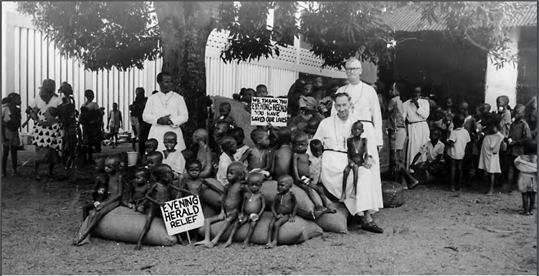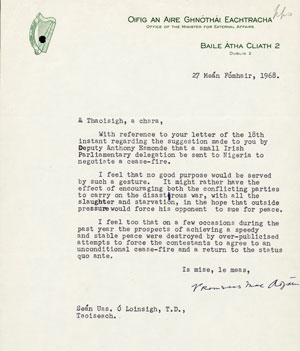ESCAPE FROM BIAFRA—AN IRISH DIPLOMAT’S ACCOUNT OF AN EVACUATION, 1967
Published in Features, Issue 6 (November/December 2022), Volume 30By John Gibney

Above: Irish ambassador Eamonn Kennedy with H.E. Sir Adesoji Aderemi, governor of Nigeria’s Western Region, 17 January 1962. Ireland’s first embassy in Africa was in Nigeria, owing to its size and importance, along with the significant Irish missionary presence there. (NA).
The ‘Republic of Biafra’ came into being in May 1967, when Nigeria’s eastern province seceded and declared itself independent. Nigeria itself had become independent in 1960; its federal structure reflected its ethnic distinctions, with the east being dominated by the Igbo (or Ibo). Following an abortive coup by Igbo officers the previous year, sectarian tensions had simmered across the federation. The consequence of secession was a civil war within weeks. The Nigerian–Biafran War loomed large in the eyes of the world from 1967 to 1970, and it looms large in the latest, thirteenth volume in the Royal Irish Academy’s Documents on Irish Foreign Policy (DIFP) series, covering the years 1965 to 1969. For many people in Ireland (and elsewhere), the best-known aspect of this conflict was the famine that led to very public efforts to provide aid relief to Biafra at the end of the 1960s (including the creation of Africa Concern, later Concern). The documents published in DIFP XIII, almost all of which are drawn from the National Archives in Dublin, reveal a lesser-known aspect of how the Irish government reacted to the conflict: by trying to evacuate Irish citizens, often missionaries, from Biafra following the outbreak of the war.

Above: September 1968—Irish Holy Ghost missionaries and Biafran children pose for a photo promoting the Evening Herald’s fund-raising appeal—typical of the prominent roles that Irish missionaries played in publicising and attempting to alleviate the famine that made Biafra a defining cause of late twentieth-century humanitarianism. (Holy Ghost Fathers)
FIRST IRISH EMBASSY IN AFRICA
Nigeria was the first African country with which Ireland established resident diplomatic relations. Along with Nigeria’s sheer size and importance, one consideration that influenced the decision was the presence of a significant, and influential, cohort of Irish missionaries in the country, mainly (though not exclusively) Catholic.
Owing to the uncertain political situation that developed throughout 1966, the welfare of Irish nationals in eastern Nigeria had been a concern for the Irish embassy in the capital, Lagos, from a relatively early stage. In August 1966 they had conducted an unofficial census of Irish nationals there, who numbered perhaps 1,500 throughout the country, with half of these in the east. Many were missionaries but there were also civilians, along with Irish nationals who had married Nigerians; missionaries and spouses were assumed to be the last who would want to leave should the situation warrant it. If it did, however, how were they supposed to leave?
One of the documents published in DIFP XIII is a report by the first secretary of the Lagos embassy, Eamon Ó Tuathail, which outlined for his superiors how so many of them ultimately did so in 1967. The US and British embassies had made contingency plans to evacuate their own nationals and to this end had created a ‘warden’ system, in which a nominated individual covering a distinct area was secretly instructed to facilitate a possible escape. Naturally, this was done discreetly, and the British had assured the Irish that they would be prepared to include Irish citizens in their own scheme if need be.
The sense of a looming crisis was not lost on the Department of External Affairs in Dublin. Ambassadors were supposed to report back to the department on a regular basis. In May 1967 the Irish ambassador to Nigeria, Kevin Rush, was reminded of his obligations to do so by Hugh McCann, the secretary of his department, who noted that reports from Lagos had been relatively infrequent in recent times. As the secession of Biafra loomed, it was vital that Rush keep his superiors informed about a rapidly evolving situation, for, as McCann put it, ‘were the situation to come to a head in the immediate future, we would be expected to have a clear, established policy’, given that the presence of large numbers of Irish nationals in eastern Nigeria was of ‘considerable concern to us’.
IRISH NATIONALS DECLINED TO USE ‘EVACUATION FACILITIES’
Much of that concern arose from how those Irish nationals might be perceived, and possibly treated, by the Nigerian federal government and its forces. As so many of the Igbo were Catholic, many missionaries might yet be identified with them. In early August 1967 Rush met Lt. Gen. Yakubu Gowon, the head of Nigeria’s incumbent military government, ‘in a relaxed and amicable atmosphere’ to set out these Irish concerns. Irish nationals were perhaps the largest remaining contingent of foreigners in Biafra at this stage and had apparently declined to use ‘evacuation facilities’, instead opting to continue their missionary work; the Irish government hoped that they would be assisted in this by the Nigerian authorities. Gowon assured Rush that Nigerian federal forces had been instructed to treat missionaries with ‘special consideration and assistance’ and that they were respected, though he also observed that the activities of some missionaries were viewed with some suspicion by the Nigerian authorities. Rush noted that he had heard that this was the case, but also that captured missionaries had been treated well and that some Irish clerics were co-operating with the Nigerian federal authorities, though Gowon was more reticent when Rush raised the issue of missionaries being taken as hostages. Rush also voiced concerns that some of their public statements might lead to missionaries being painted as ‘collaborators’, along with suggestions that they were involved in atrocities.
The ambassador’s approach to the Nigerian leader had not come out of the blue; irrespective of Gowon’s assurances, it was obvious that the Irish citizens and missionaries could yet be in danger, given the nature of the crisis that was emerging. From early in 1967 Ó Tuathail had discreetly been travelling around eastern Nigeria to examine how the ‘warden’ system proposed by US and British diplomats might work in practice. In doing so he had encountered a problem: many of the Catholic missionaries and clergy were wary of inclusion in any British scheme for various reasons, not least that they might be tainted by association with the increasingly unpopular British and that any decision to leave would damage their reputation anyway. Rush subsequently explained to the Nigerian Catholic hierarchy—many of whom were Irish by birth—about his embassy’s lack of resources and proposed a compromise: that the bishops themselves nominate ‘coordinators’ who could liaise with the existing warden system, thereby distancing themselves from direct participation.
Since early May Ó Tuathail had been based in eastern Nigeria to keep in touch with Irish nationals in the east and was being assisted by the British officials as he did so (they even provided him with office space). Communication outside Nigeria was via British and US channels, until even that eventually became impossible. In early June, 23 Irish nationals were evacuated as part of a British airlift from the Nigerian coastal city of Port Harcourt to Lagos. Fighting between Biafran and Nigerian forces was by now in full swing, and by July the prospect of a federal victory increased tensions among expatriates, who feared attack; consequently, the British and Americans obtained permission for an Italian vessel to evacuate their nationals and others from Port Harcourt.
RECOGNITION OF THE BIAFRAN REGIME

AAbove: A letter from Minister for External Affairs Frank Aiken to Taoiseach Jack Lynch, reproduced in DIFP XIII. Aiken was wary of suggestions that Ireland should become involved in the conflict in any way. (NA).
By mid-August 1969, between this and other avenues of escape, ‘the number of Irish citizens had been reduced to some 450 missionaries and only a very small number of lay people’. In the same month, however, Ó Tuathail’s position was complicated when the thorny issue of formally recognising the secessionist Biafran regime arose. This was bound to alienate the federal government in Lagos and could yet imperil Irish nationals (Minister for External Affairs Frank Aiken remained opposed to this for the duration of the conflict). The best option for Ó Tuathail, it seemed, was to ‘stall for time’ and not to object to any titles the Biafran administration might wish to use; he should ‘behave with as much flexibility as common sense indicates and as prudence allows’. Ó Tuathail was popular with Irish nationals, but the Biafrans were unlikely to expel him even if recognition of their independence was not forthcoming from Dublin. It was essential, in Dublin’s view, that he remain in place ‘so long as there are any Irish citizens in danger (or likely to be in danger) in Biafra’. His purpose was to ensure their protection as best he could.
In late October, as the conflict escalated, Ó Tuathail urged the religious orders to evacuate their personnel while it was still possible. Most did, though some were reluctant. Some Irish missionaries were evacuated by Biafran aircraft, though as these were often used to ferry weapons Ó Tuathail thought it sensible not to get directly involved. He had decided to leave Biafra on 15 October but delayed his departure to ensure that as many Irish as possible were evacuated. As it happened, Ó Tuathail departed Biafra for Angola on 2 November, on a charter plane that, ironically, had transported weapons on its inward flight.
By the time Ó Tuathail left, he later noted, there were ‘267 Irish nationals (189 men and 78 women) remaining in “Biafra”’; all but three were missionaries. The missionaries were well stocked with supplies and, in his view, were safe while Biafra held out, though it was impossible to predict the future course of events. It would now also be difficult, in his view, to get reports from inside Biafra (Ó Tuathail himself was not sent back to Lagos after his return to Ireland). This proved not to be the case: concern for the safety of Irish missionaries eventually gave way to concern about their activities in Biafra, as many of them took prominent roles in publicising and attempting to alleviate the famine that made Biafra a defining cause of late twentieth-century humanitarianism.
In December 1967, however, this lay in the future, as Ó Tuathail provided an immensely detailed account for his superiors of how he had tried to safeguard Irish nationals in Nigeria up to his departure; both this account and many more documents that touch on the Irish responses to the conflict have now been published for the first time in DIFP XIII. While no one set of records can reveal the totality of the past, the records of the Irish foreign service offer a rich seam of material that reveals how the Irish state reacted to both the war and the short-lived ‘Republic of Biafra’.
John Gibney is Assistant Editor with the Royal Irish Academy’s Documents on Irish Foreign Policy project. Documents on Irish Foreign Policy, Vol. XIII: 1965–1969 is now available from the Royal Irish Academy.
Further reading
M. Kennedy, E. O’Halpin, K. O’Malley, B. Whelan, K. O’Sullivan, J. Redmond & J. Gibney (eds), Documents on Irish Foreign Policy, Vol. XIII: 1965–1969 (Dublin, 2022).
K. O’Sullivan, Ireland, Africa and the end of empire: small state identity in the Cold War, 1955–75 (Manchester, 2012).
















